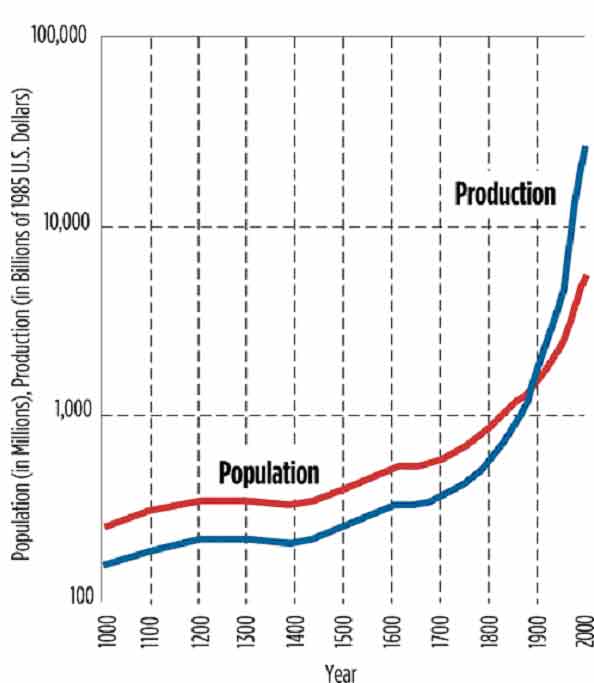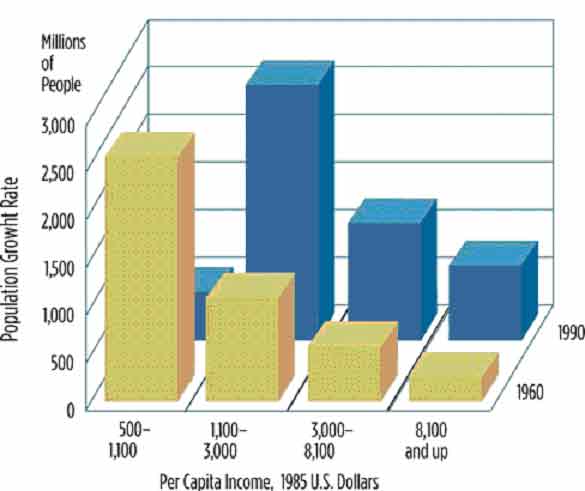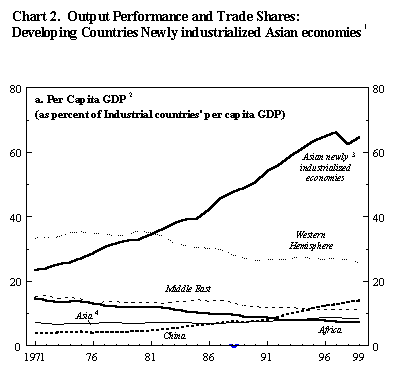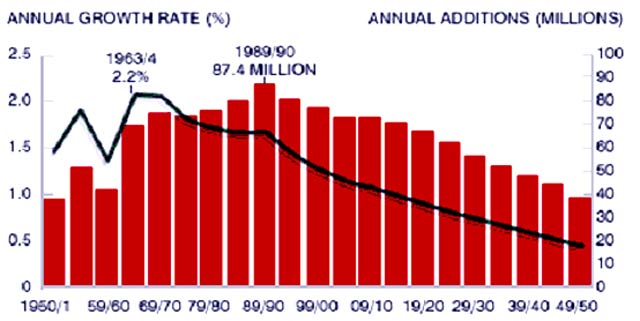Speculation
Where Lies the Future?The only thing we know about the future is that it will be different. - Peter F Drucker What does the future hold in the areas of job opportunities in a global economy and standard of living in a transitional society? It seems most likely that job opportunities should abound and that standards of living should continue to improve. Our knowledge of various places and times has grown exponentially in the past few decades. The most recent contribution to the world’s knowledge storehouse is the Penn World Table project (headed by Robert Summers and Alan Heston). This project has generated population and production data on every country in the world beginning between 1950 or 1960 (varying by country) up to now. This data mine serves up comparable information on societies both rich and poor and the results have been a bit surprising. Over the 40 years from 1960 until the end of the millennium, earth’s human population swelled from 3 billion to 6.1 billion, an annual growth rate of 1.7%. Many people suggest that this growth is demonstrably outstripping earth’s available resources and the human race is blindly reproducing itself toward poverty and starvation. But the data show that this is simply nonsense (Lucas). Though poverty and starvation are to be found aplenty, poverty is not increasing. Over that same 40-year period, world production grew even faster - from $6.5 trillion in 1960 to $31 trillion in 2000 (for comparison, all dollars have 1985 values). While the population doubled, production increased five times over, growing at 4% annually. That means the living standard of the average person more than doubled (that’s including all countries, both rich and poor). Therefore, the entire human race is getting rich at an unprecedented rate (see Figure 1).
Figure 1: World Population and Production (Lucas) How could this not be viewed positively? Some express concern that wealth is too unevenly distributed. If this is so, should the government redistribute it more fairly? The premises of the welfare state are:
In a market-based society, individuals gain wealth when they produce goods demanded by large numbers of people. Indeed, when the system works, wealth is simply a proxy or token for the good that the individual has done for society. (Henry Ford became rich producing cars while the makers of early luxury vehicles affordable only by the rich didn’t.) Ford made cars most could afford while keeping his costs low enough to make a profit (Anderson). Success occurs when consumers purchase on a large scale. The first point above does not explain how transfer of wealth from the poor to the rich takes place - this is because, in actuality, economic exchanges create mutual beneficiaries. Wealth transfers, on the other hand, inhibit economic growth, punish the successful and cause less wealth to be created in the future. If governments impede creation and distribution of wealth, then there will soon be less of it. People on the margins are the first to be hurt so a welfare state actually makes the poor worse off in the long run (Anderson). Moreover, worldwide distribution of wealth, while certainly not even, has improved markedly in the past 40 years and there is no reason to suspect that this improvement will not continue (see Figure 2).
Figure 2: Income Distribution (Lucas). Good job opportunities depend on education. Low-level jobs depend on a pool of people who will work for low pay. When people are steadily employed - even at low pay - long enough for their children to be fed well enough to be healthy and to receive a basic education, then the wealth-distribution picture begins to improve. Accelerating global changes have coincided with unprecedented growth in the size of the population of youth in developing countries. In 2005, the total number of 10-to-24-year-olds was expected to reach 1.5 billion, 86% of whom live in developing countries. (This group represents 30% of the population in those countries.) In much of the developing world, adolescence as a stage of life has only recently gained in significance - the young once moved directly from childhood to adulthood; now the interval between is extended. Youth enter adolescence earlier, are healthier, more likely to be in school, to postpone working, and to delay marriage and childbearing. Unfortunately, varying circumstances across regions mean experiences of being young diverge. Because there are more people today, there are as many youth in poverty today as in the past - despite declining poverty rates. Approximately 325 million youth in developing countries grow up on less than $1 a day. Growing pressure on school systems in those countries compromises already-poor quality. Though fewer young people are marrying or having children during adolescence many (especially Africans) lack opportunities to use this phase of their lives to acquire education/training, making implications of globalization very different for them (Lloyd). Adequate preparation for key adult roles (worker, citizen, spouse, parent, household manager) is important. Most needed are good health and knowledge of how to keep it, a social network, coherent values, the ability to contribute to the collective community well-being, understanding of what is required of an adult (with role models available), personal competence and (ideally), a sense of well-being (Lloyd). Yes, poverty is unquestionably the greatest enemy of successful transitions to adulthood - but, if nothing else, when no cheap country is left to which to outsource menial work for cheap labour, even Africa should have her turn. World conditions ought to continue to improve. Regarding the common fear of too many people in the future, society seems to have a built-in mechanism for regulating fertility - the demographic transition which occurs when people are finally empowered to take charge of their own lives. Extrapolating the 2% population growth rate backward from 1960, one would conclude that Adam and Eve were expelled from the garden in about the year 1000. Extrapolating the 2.2% rate of per capita income growth backward, one would infer that people in 1800 subsisted on less than $100 per year. Extrapolating forward leads to predictions that the earth’s water supply (or supply of anything else) will be exhausted in a finite period. Since you cannot extrapolate backward, there is no reason to suppose you can extrapolate forward. "Such exercises make it clear that the years since 1960 are part of a period of transition, but from what to what?" (Lucas). A spirit of optimism for the future seems much more justified than the "doom and gloom" position. Humans are adaptable and resourceful - and impatient. The way ahead is not smooth, nor is it guaranteed. But indications point to a desirable future for our children and their children - and that’s probably the point of it all. Works Cited
AnnotationsWilliam Anderson is an adjunct scholar of the Mises Institute. He teaches economics at Frostburg State University. Cynthia B Lloyd is director of social science research in the Policy Research Division at the Population Council. She serves on the National Research Council’s Committee on Population. Prior to that, she was chief of the fertility and family planning studies section at the United Nations Population Division and assistant professor of economics, Barnard College, Columbia University. Her MA and PhD in economics are from Columbia University. Robert E Lucas Jr received the Nobel Memorial Prize in Economic Sciences in 1995. He is past president of the Econometric Society and the American Economic Association, fellow of the American Academy of Arts and Sciences and the American Philosophical Society and member of the National Academy of Sciences.
Graphic Examples of Africa's Lagging Development
The View from 1988...The Doomsday Equationby Nigel Bunce and Jim Hunt In 1960, three electrical engineers at the University of Illinois published a paper in the journal Science entitled, "Doomsday: Friday, 13 November AD 2026". In this paper, they proposed a novel way to analyse the past record of the earth's human population and to predict its immediate future. Scientists have been attempting such predictions for many years. The simplest view is to assume that the rate of growth is proportional to the number already in the population. This kind of analysis has been shown to be correct for many living populations, for example, bacteria in a growing culture, or insects with an infinite food supply. In such cases, a population of 2000 individuals increases twice as fast as a population of 1000. Such growth is called "constant percentage" or "exponential growth". Your bank savings account, if left alone, grows this way. In a finite environment, the population will grow exponentially at first and then level off, or even decline if the food supply is not renewable. All such population models can be represented with simple mathematics. What the three engineers did was to attempt to take into account the ability of a population to communicate, think, plan and employ technology to expand the fraction of the environment available for the support of the population. The result they got was a surprise and a shock. The equation they derived had what is termed in mathematics as a "singularity", that is, at a certain finite time, the population would go to infinity. Such "critical" equations are quite common in the description of scientific processes. Of course, the process doesn't actually go to infinity but the singularity indicates a critical point where the process becomes very large very rapidly and exhibits very large fluctuation. The paper generated a storm of protest both in the scientific and in the lay press. Both Time and The New York Times commented on it and that great popular philosopher Walt Kelly devoted three strips of Pogo to the "Doomsday Equation". The equation was remarkably successful at accounting for the world's population for a very long period. It represented to within 7% the best known data from the time of the Caesars up to the present. It also gave 13 November 2026 as the date of the critical Doomsday. If the equation is to be proven incorrect then at some time before 2026 the earth's population is going to have to lag behind the prediction and it had better do it soon, since 2026 is only 66 years after the date of the paper and only 38 years from now! How are we doing? In a recent issue of Science, Stuart Umpleby of George Washington University examined the question and found that we are not doing very well. In 1975, the equation predicted 3.65 billion and the earth's population was 3.97 billion! In 1980, the equation predicted 3.97 billion but we numbered 4.4 billion. We reached 5 billion in July, 1986 but the equation said that wouldn't happen until 1989. The result is that far from the population falling below the disastrous predictions of the Doomsday equation, we are heading for Doomsday at an even greater rate! The question now is: When will the equation start to fail since it must fail, that is, when will the rate of population increase slow down? A further question is: What method will be employed by man or nature to make it fail? The methods have traditionally been: war, famine and pestilence. College of Physical Science Source: physics.uoguelph.ca The Science Corner 18 February 1988 |
 Animals
Animals Animation
Animation Art of Playing Cards
Art of Playing Cards Drugs
Drugs Education
Education Environment
Environment Flying
Flying History
History Humour
Humour Immigration
Immigration Info/Tech
Info/Tech Intellectual/Entertaining
Intellectual/Entertaining Lifestyles
Lifestyles Men
Men Money/Politics/Law
Money/Politics/Law New Jersey
New Jersey Odds and Oddities
Odds and Oddities Older & Under
Older & Under Photography
Photography Prisons
Prisons Relationships
Relationships Science
Science Social/Cultural
Social/Cultural Terrorism
Terrorism Wellington
Wellington Working
Working Zero Return Investment
Zero Return Investment






